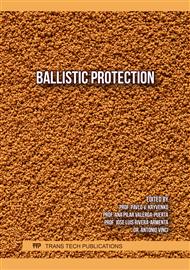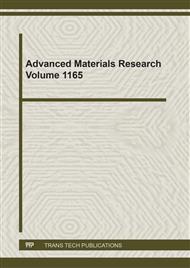[1]
N. Shaari, A. Jumahat, and M. K. M. Razif, Impact resistance properties of Kevlar/glass fiber hybrid composite laminates,, Jurnal Teknologi, vol. 76, no. 3, p.93–99, 2015,.
DOI: 10.11113/jt.v76.5520
Google Scholar
[2]
S. L. Valenҫa, S. Griza, V. G. de Oliveira, E. M. Sussuchi, and F. G. C. de Cunha, Evaluation of the mechanical behavior of epoxy composite reinforced with Kevlar plain fabric and glass/Kevlar hybrid fabric,, Composites Part B: Engineering, vol. 70, p.1–8, 2015,.
DOI: 10.1016/j.compositesb.2014.09.040
Google Scholar
[3]
S. Fidan, T. Sinmazcelik, E. Avcu, M. O. Bora, and O. Coban, Detecting impact damages in an aramid/glass fiber reinforced hybrid composite with micro tomography,, Advanced Materials Research, vol. 445, p.9–14, 2012,.
DOI: 10.4028/www.scientific.net/amr.445.9
Google Scholar
[4]
M. M. Ansari and A. Chakrabarti, Behaviour of GFRP composite plate under ballistic impact: Experimental and FE analyses,, Structural Engineering and Mechanics, vol. 60, no. 5, p.829–849, 2016,.
DOI: 10.12989/sem.2016.60.5.829
Google Scholar
[5]
X. Xu, Z. Zhou, Y. Hei, B. Zhang, J. Bao, and X. Chen, Improving compression-after-impact performance of carbon-fiber composites by CNTs/thermoplastic hybrid film interlayer,, Composites Science and Technology, vol. 95, p.75–81, 2014,.
DOI: 10.1016/j.compscitech.2014.01.023
Google Scholar
[6]
M. T. H. Sultan, S. Basri, A. S. M. Rafie, F. Mustapha, D. L. Majid, and M. R. Ajir, High velocity impact damage analysis for glass epoxy - Laminated plates,, Advanced Materials Research, vol. 399–401, p.2318–2328, 2012,.
DOI: 10.4028/www.scientific.net/amr.399-401.2318
Google Scholar
[7]
E. Randjbaran, R. Zahari, N. A. Abdul Jalil, and D. L. Abang Abdul Majid, Hybrid Composite Laminates Reinforced with Kevlar/Carbon/Glass Woven Fabrics for Ballistic Impact Testing,, The Scientific World Journal, vol. 2014, p.413753, 2014,.
DOI: 10.1155/2014/413753
Google Scholar
[8]
J. Gustin, A. Joneson, M. Mahinfalah, and J. Stone, Low velocity impact of combination Kevlar/carbon fiber sandwich composites,, Composite Structures, vol. 69, no. 4, p.396–406, 2005,.
DOI: 10.1016/j.compstruct.2004.07.020
Google Scholar
[9]
K. S. Pandya, J. R. Pothnis, G. Ravikumar, and N. K. Naik, Ballistic impact behavior of hybrid composites,, Materials and Design, vol. 44, no. February, p.128–135, 2013,.
DOI: 10.1016/j.matdes.2012.07.044
Google Scholar
[10]
R.J. Muhi, F. Najim, and M. F. S. F. de Moura, The effect of hybridization on the GFRP behavior under high velocity impact,, Composites Part B: Engineering, vol. 40, no. 8, p.798–803, 2009,.
DOI: 10.1016/j.compositesb.2009.08.002
Google Scholar
[11]
B. Z. Jang, L. C. Chen, C. Z. Wang, H. T. Lin, and R. H. Zee, Impact resistance and energy absorption mechanisms in hybrid composites,, Composites Science and Technology, vol. 34, no. 4, p.305–335, 1989,.
DOI: 10.1016/0266-3538(89)90002-x
Google Scholar
[12]
K. H. Ghlaim, H. Tawfiq, and A. Hussain Al-Hilli, Effects of Hybrid Arrangement and Location of the Stronger Layer on the Impact Resistance of Composite Plate Target,, Journal of Engineering and Development, vol. 13, no. 1, (2009).
Google Scholar
[13]
M. B. Mukasey, J. L. Sedgwick, and D. W. Hagy, Ballistic Resistance of Body Armor,, NIJ Standard - 0101-16, p.1–89, (2008).
Google Scholar
[14]
D. of Defense, Mil-Std-662F Test Method Standard V 50 Ballistic Test for Armor,, no. January 1987, (1997).
Google Scholar
[15]
D. Zhang, Y. Sun, L. Chen, S. Zhang, and N. Pan, Influence of fabric structure and thickness on the ballistic impact behavior of Ultrahigh molecular weight polyethylene composite laminate,, Materials and Design, vol. 54, 2014,.
DOI: 10.1016/j.matdes.2013.08.074
Google Scholar
[16]
P. Wambua, B. Vangrimde, S. Lomov, and I. Verpoest, The response of natural fibre composites to ballistic impact by fragment simulating projectiles,, Composite Structures, vol. 77, no. 2, p.232–240, 2007,.
DOI: 10.1016/j.compstruct.2005.07.006
Google Scholar



